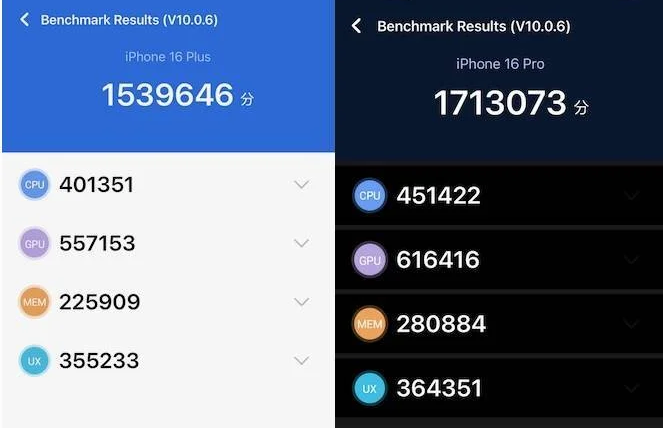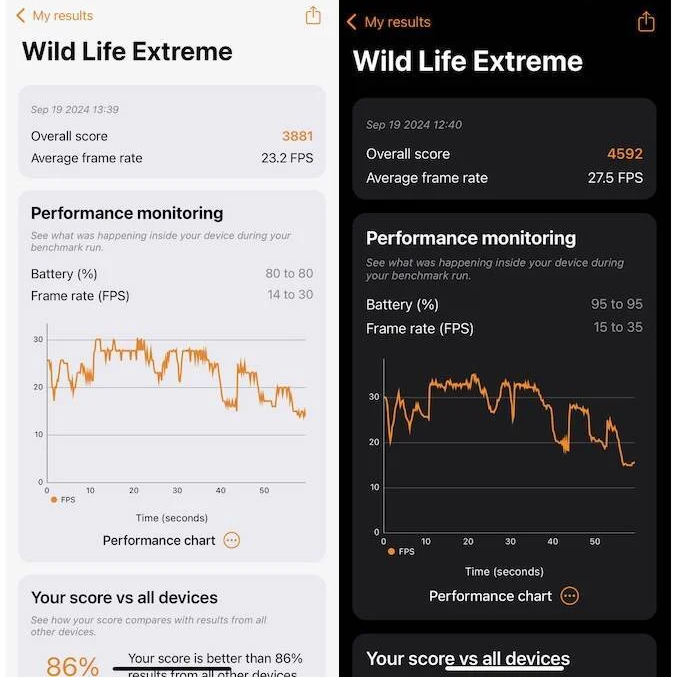
How is the iPhone 16 Pro different in configuration from the regular iPhone 16?
One of the notable upgrades of the iPhone 16 series compared to the iPhone 15 launched last year is that they are all equipped with the brand new A18 chip. Of which, the iPhone 16 and 16 Plus duo will use the A18 chip, while the iPhone 16 Pro and 16 Pro Max will use the A18 Pro chip.
Apple said the new A18 chip duo are both built on a 3nm process and have 6 processing cores, including 2 high-performance processing cores and 4 energy-saving processing cores. But "apple" did not disclose the maximum clock speed of the cores on its new chip.
The difference is that the A18 Pro chip is equipped with 6 graphics processing cores, while the A18 chip only has 5 graphics processing cores. This will help the A18 Pro chip run heavy graphics tasks such as video processing, gaming... more smoothly.
Apart from the difference in the type of chip used, the other configuration parameters on the regular iPhone 16 and iPhone 16 Pro duo are almost the same. The comparison table below will show the configuration differences on the 4 versions of the iPhone 16:

Configuration comparison table of iPhone versions (Click on image to view large size).
How is the A18 Pro chip more powerful than the A18?
So does the A18 Pro chip equipped on the iPhone 16 Pro really have superior processing performance compared to the regular A18 chip? Technology site PCMag used chip performance benchmarking tools to find the answer.
Overall Performance Processing Score
First, PCMag used the AnTuTu tool to benchmark the A18 and A18 Pro chips. AnTuTu is an application that evaluates all aspects of a processor chip, including the central processing unit (CPU) and the graphics processing unit (GPU).

Compare the overall processing score of the iPhone 16 Plus with A18 chip (left) and iPhone 16 Pro with A18 Pro chip (right) using AnTuTu tool (Photo: PCMag).
The test results with the AnTuTu application show that the A18 chip achieved a total score of 1,539,646, while the A18 Pro achieved a score of 1,713,073. Thus, the difference in the overall processing score of these two chips is about 10.1%.
CPU Processing Score
PCMag continues to use the Geekbench 6 tool to score the iPhone 16 and 16 Pro's processor chips. This is an application commonly used to evaluate CPU processing performance, including scoring the processing speed when running a single core and running all cores on the chip.

The A18 Pro chip (right) scores significantly higher in single-core and multi-core tests than the A18 chip (Photo: PCMag).
The results show that the A18 scored 3,091 in the single-core performance test and 7,129 in the multi-core performance test. In the same test, the A18 Pro chip scored 3,279 and 7,855, respectively. The difference between the A18 and A18 Pro chips is not too significant, with only a 4.5% and 10.1% difference in the single-core and multi-core performance tests.
PCMag also used Geekbench to benchmark the Snapdragon 8 Gen 3 chip in the Galaxy S24 Ultra, scoring 2,273 on single-core and 7,056 on multi-core. Similarly, the Tensor 4 chip in the Google 9 Pro XL scored 1,961 and 4,718, respectively.
This shows that the A18 and A18 Pro chips offer superior processing performance compared to the Galaxy S24 Ultra and Pixel 9 Pro XL.
Graphics processing capability score
The biggest difference between the A18 and A18 Pro chips is the graphics processing capability, as the A18 is only equipped with 5 graphics processing cores, while the A18 Pro has 6 cores. Therefore, PCMag used the 3Dmark Wild Life Extreme tool to score the graphics processing capabilities of these two chips.
3Dmark Wild Life Extreme will run a simulated environment on the iPhone just like when playing a game to test whether the device is capable of handling high frame rate graphics.

The A18 Pro chip (right) scores better in graphics processing and frame rate processing than the A18 chip (Photo: PCMag).
The test results show that the A18 chip scored 3,881, with an average processing speed of 23.2 frames per second. Meanwhile, the A18 Pro chip scored 4,592 and an average processing speed of 27.5 frames per second. The difference in graphics processing capabilities between the two chips is 15.5%, showing that the additional graphics processing core on the A18 Pro really comes into play.
3DMark says the A18 and A18 Pro chips' test results are better than 86% and 90% of all devices that have run its tests.
GFXBench is another test commonly used to evaluate smartphone graphics performance. PCMag used this tool to benchmark the A18 and A18 Pro chips, with the final result showing that the A18 Pro continues to excel in graphics processing.
GFXBench's benchmark results also show that the A18 Pro chip is superior in graphics processing capabilities compared to the chips on the Galaxy S24 Ultra and Pixel 9 Pro XL.

